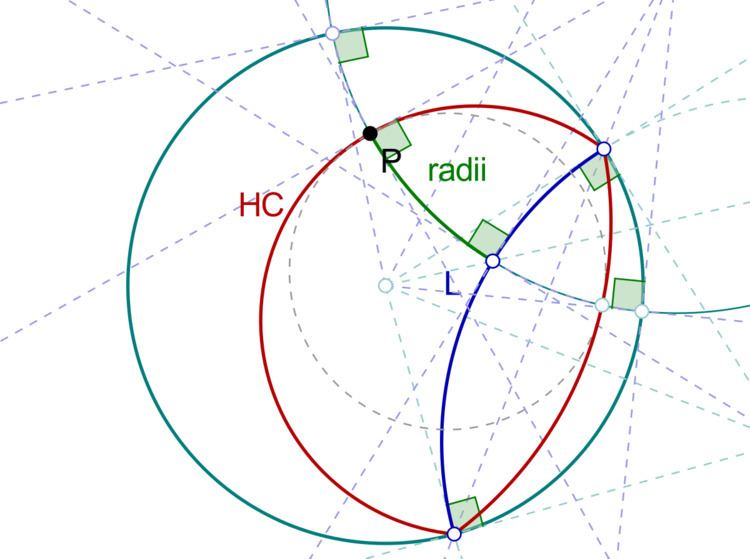In hyperbolic geometry, a hypercycle, hypercircle or equidistant curve is a curve whose points have the same orthogonal distance from a given straight line (its axis).
Given a straight line L and a point P not on L, one can construct a hypercycle by taking all points Q on the same side of L as P, with perpendicular distance to L equal to that of P.
The line L is called the axis, center, or base line of the hypercycle.
The lines perpendicular to the axis, which is also perpendicular to the hypercycle are called the normals of the hypercycle.
The segments of the normal between the axis, and the hypercycle are called the radii.
Their common length is called the distance or radius of the hypercycle.
The hypercycles through a given point that share a tangent through that point converge towards a horocycle as their distances go towards infinity.
Hypercycles in hyperbolic geometry have some properties similar to those of lines in Euclidean geometry:
In a plane, given a line and a point not on it, there is only one hypercycle of that of the given line (compare with Playfair's axiom for Euclidean geometry).No three points of a hypercycle are on a circle.A hypercycle is symmetrical to each line perpendicular to it. (Reflecting a hypercycle in a line perpendicular to the hypercycle results in the same hypercycle.)Hypercycles in hyperbolic geometry have some properties similar to those of circles in Euclidean geometry:
A line perpendicular to a chord of a hypercycle at its midpoint is a radius and it bisects the arc subtended by the chord.Let AB be the chord and M its middle point.By symmetry the line R through M perpendicular to AB must be orthogonal to the axis L.Therefore R is a radius.Also by symmetry, R will bisect the arc AB.The axis and distance of a hypercycle are uniquely determined.Let us assume that a hypercycle C has two different axes L 1 and L 2 .Using the previous property twice with different chords we can determine two distinct radii R 1 and R 2 . R 1 and R 2 will then have to be perpendicular to both L 1 and L 2 , giving us a rectangle. This is a contradiction because the rectangle is an impossible figure in hyperbolic geometry.Two hypercycles have equal distances iff they are congruent.If they have equal distance, we just need to bring the axes to coincide by a rigid motion and also all the radii will coincide; since the distance is the same, also the points of the two hypercycles will coincide.Vice versa, if they are congruent the distance must be the same by the previous property.A straight line cuts a hypercycle in at most two points.Let the line K cut the hypercycle C in two points A and B. As before, we can construct the radius R of C through the middle point M of AB. Note that K is ultraparallel to the axis L because they have the common perpendicular R. Also, two ultraparallel lines have minimum distance at the common perpendicular and monotonically increasing distances as we go away from the perpendicular.This means that the points of K inside AB will have distance from L smaller than the common distance of A and B from L, while the points of K outside AB will have greater distance. In conclusion, no other point of K can be on C.Two hypercycles intersect in at most two points.Let C 1 and C 2 be hypercycles intersecting in three points A, B, and C.If R 1 is the line orthogonal to AB through its middle point, we know that it is a radius of both C 1 and C 2 .Similarly we construct R 2 , the radius through the middle point of BC. R 1 and R 2 are simultaneously orthogonal to the axes L 1 and L 2 of C 1 and C 2 , respectively.We already proved that then L 1 and L 2 must coincide (otherwise we have a rectangle).Then C 1 and C 2 have the same axis and at least one common point, therefore they have the same distance and they coincide.No three points of a hypercycle are collinear.If the points A, B, and C of a hypercycle are collinear then the chords AB and BC are on the same line K. Let R 1 and R 2 be the radii through the middle points of AB and BC. We know that the axis L of the hypercycle is the common perpendicular of R 1 and R 2 .But K is that common perpendicular. Then the distance must be 0 and the hypercycle degenerates into a line.The length of an arc of a hypercycle between two points islonger than the length of the line segment between those two points,shorter than the length of the arc of one the two horocycles between those two points, andshorter than any circle arc between those two points.A hypercycle and a horocycle intersect in at most two points.In the hyperbolic plane of constant curvature − 1 , the length of an arc of a hypercycle can be calculated from the radius r and the distance between the points where the normals intersect with the axis d using the formula:
l = d cosh r In the Poincaré disk model of the hyperbolic plane, hypercycles are represented by lines and circle arcs that intersect the boundary circle at non-right angles. The representation of the axis intersects the boundary circle in the same points, but at right angles.
In the Poincaré half-plane model of the hyperbolic plane, hypercycles are represented by lines and circle arcs that intersect the boundary line at non-right angles. The representation of the axis intersects the boundary line in the same points, but at right angles.

